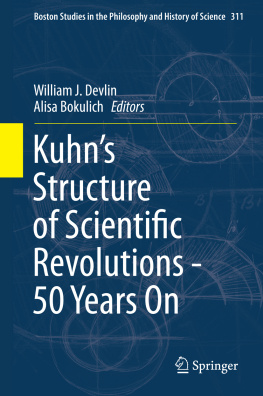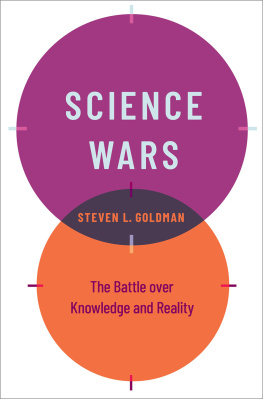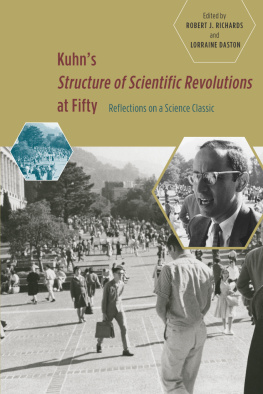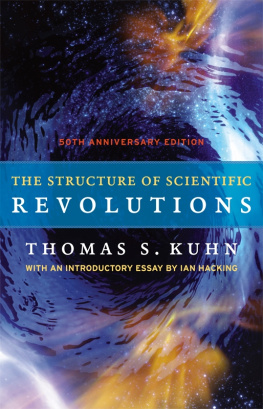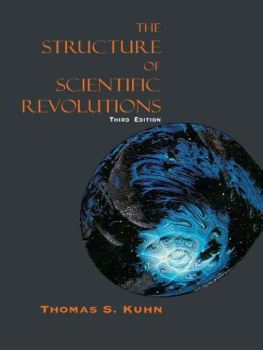1. Introduction
In Spring of 2012, the Center for Philosophy and History of Science at Boston University hosted a session of the Boston Colloquium celebrating the 50th anniversary of Thomas Kuhns Structure of Scientific Revolutions (henceforth, Structure ).This colloquium brought together many of the worlds leading scholars on Kuhn and we were honored to have the Kuhn family present as well to share their own personal stories and perspectives about Thomas Kuhn and his work. It was not the first time the Center had marked an anniversary of this book: In 1982 Kuhn himself had come to speak in the Boston Colloquium about his Structure 20 years on.What is remarkable about this book, which has sold well over a million copies, is that it continues to shape the history and philosophy of science and popular thinking as much today, 50 years on, as it did 20 years on, though perhaps not in exactly the same way. Exploring just what the legacy of Kuhns Structure is 50 years on is the subject of this volume. While the inspiration for this volume came from this colloquium, several additional scholars representing diverse perspectives within the history and philosophy of science have contributed papers.
As Kuhn himself explained, the central ideas of Structure were motivated by his time as a graduate student in the summer of 1947 when he attempted to read, and understand, Aristotles Physics through the perspective of Newtonian mechanics. Realizing Aristotle knew nearly nothing about mechanics, Kuhn eventually came to the view that Aristotelian science was not simply a system of egregious mistakes, but that it belonged to a self-contained and successful scientific tradition. This idea gave rise to Kuhns famous concept of scientific revolutions (Kuhn, [
There are at least three central themes in Structure. One is that science operates within paradigms , which Kuhn describes as consisting of unprecedented scientific achievements that are sufficiently open-ended and successful to attract a group of adherents to focus on resolving the remaining problems (Kuhn [, pp. 186187). They are models of how members of a disciplinary matrix should conduct scientific investigations, including theories and their application, the method of observation (i.e., what they are looking for in their experiments), and which instruments to use and how to apply them.
Another central theme of Structure is the historical pattern of theory change in the development of science.
While the resolution of a revolution entails a paradigm-shift, the comparison between an old and new paradigm leads to the third and, as James Conant and John Haugeland describe, the most widely criticized (Kuhn
Kuhn recognized that, when taken together, these three themes of paradigms, scientific change, and incommensurability, give rise to new picture of the enterprise of science. Kuhn closes Structure (XII) by rejecting the idea that science develops by accumulating truths about nature and he concludes that these central ideas lead to a rejection of scientific realism.
The central ideas of Structure have undeniably had a profound effect on studies in the history and philosophy of science over the past 50 years. However, Structure has certainly not been without its critics. Not long after its publication, it was beset with philosophical criticism: for example, Dudley Shapere, Israel Scheffler, and Karl Popper each maintained that Kuhns account of scientific change entails that theory-choice is subjective and irrational. As we shall see, it has occupied the careers of many other scholars in the 50 years since Structure as well.
In the second chapter, Steven Shapin examines Structure as an argument about the nature of science. Here, Shapin focuses on understanding Structure by exploring the specific historical circumstances from which it originated. In particular, Shapin provides an account of the conditions of possibility for the naturalistic sentiments of the booksentiments which help give rise to the central components of the work, such as paradigms, revolutions, normal science, truth, reason, reality, and progress. In his description of the historicity of these sentiments, Shapin argues that the conditions of possibility of these sentiments concern changes to the political and economic circumstances of science in the twentieth century. Shapin turns to three texts, each published a year apart from Structure , which help to show that science was becoming institutionally and culturally normalized: (1) President Eisenhowers Farewell Address; (2) Alvin Weinbergs paper, Impact of Large-Scale Science on the United States; and (3) Derek de Sollar Prices Little Science, Big Science . Shapin concludes that this institutionalization and cultural normalization of science served as the conditions that made Kuhns naturalistic approach towards science in Structure possible.
In Chapter Three, Alexander Bird shows that Kuhns thinking about the nature of the history of science can be illuminated by examining two distinct strands of historicism found in the work of Hegel. First, Bird maintains that Kuhns historical approach to sciencei.e., Kuhns view that, methodologically, we examine the history of the scientific tradition and the historical context of the development of scientific ideas to understand scientific changeexemplifies Hegels conservative strand of historicism. Second, Bird shows that, given Kuhns identification of the cyclical patterns of normal and revolutionary science, Kuhn exemplifies Hegels determinist strand of historicism. Furthermore, Bird holds that, together, these two strands of historicism in Kuhns thinking complement one another. On the one hand, the determinist strand provides us with Kuhns belief of the cyclical patterns of scientific change. On the other hand, the conservative strand explains those patterns. From this he argues that Kuhn should be understood as adopting internalism towards scientific change. Finally, given Kuhns internalism, Bird shows why Kuhn rejected certain forms of social constructivism.
In Chapter Four, Alan Richardson examines how Kuhn conceived of the relationship between the history of science and the philosophy of science, and draws out its implications for our understanding of this relationship today. He points out that Kuhn was quite conscious of the different goals and interests in history and philosophy as he developed Structure . This suggests that the role for history in Structure is more subtle than we normally think. Structure , according to Richardson, should not be read primarily as a philosophical treatise that presents the shortcomings of logical empiricism and offers a new view that resolves such problems. Instead, we should understand that it begins with historiographic questions and thereby suggests that logical empiricism gives the wrong advice about what questions are important to the historian of science. Likewise, Kuhn recognized that, by holding to the view that theories are simply sets of laws, philosophers were not able to properly reconstruct the process of theory development or evaluation. In thinking about the nature of philosophy and history, however, Richardson argues that we should eschew stereotypical dichotomies, such as universal versus particular, timeless versus timebound, or normative versus descriptive.Instead, Richardson concludes that we should use Kuhns emphasis on the practices of history and philosophy to help us think about how history of science and philosophy of science can best work together today, by better articulating their own explanatory projects.

